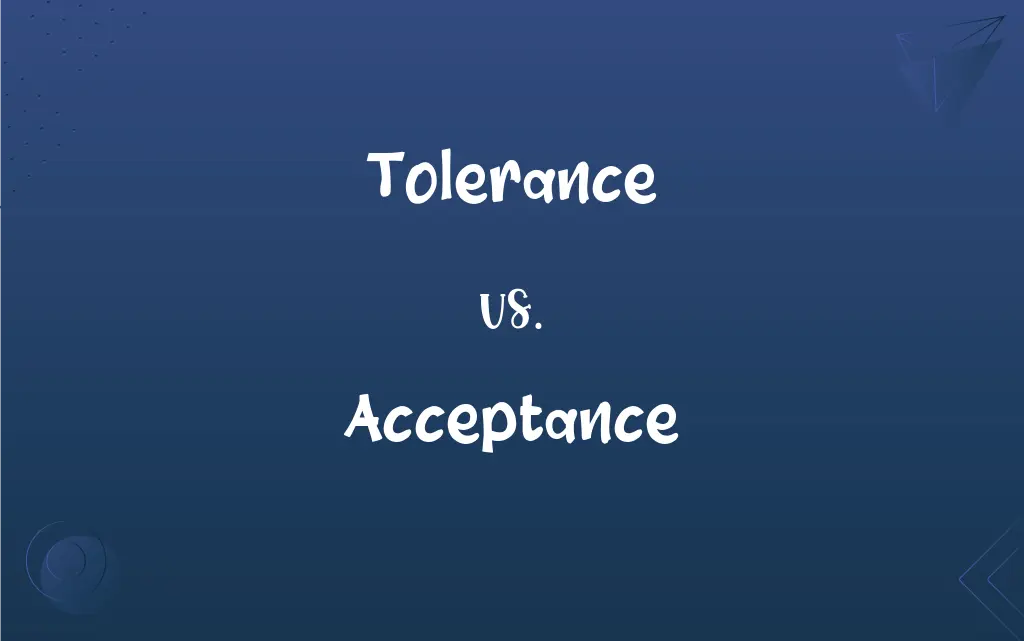Tolerance vs. Acceptance: What's the Difference?
Edited by Aimie Carlson || By Harlon Moss || Published on January 22, 2024
Tolerance is enduring differences without interference, while acceptance involves embracing and acknowledging differences positively.

Key Differences
Tolerance implies a willingness to allow the existence of opinions or behaviors one does not necessarily agree with, often without endorsement. Acceptance, however, goes a step further, involving recognition, respect, and often positive affirmation of those differences.
Tolerance can exist with underlying disagreement or disapproval, while acceptance requires a more open and embracing attitude. Tolerance is about coexistence in spite of differences, whereas acceptance is about embracing diversity as a positive aspect.
Tolerance is often seen as a passive approach, where one refrains from interfering with what they don’t agree with. Acceptance is active, involving a conscious decision to understand, respect, and include differences.
In terms of social dynamics, tolerance can maintain a status quo without challenging one's own beliefs. Acceptance, conversely, often requires a change in personal attitude and can lead to more inclusive and harmonious social interactions.
Tolerance can be a first step towards acceptance, providing a base level of respect. However, true acceptance implies a deeper level of understanding and integration of diversity in one’s worldview.
ADVERTISEMENT
Comparison Chart
Definition
Enduring differences without interference
Embracing and acknowledging differences
Attitude
Passive, may involve disagreement
Active, open, and embracing
Approach
Non-interference despite disapproval
Positive affirmation and inclusion
Impact on Beliefs
Maintains personal beliefs
Often changes or expands personal beliefs
Social Dynamics
Allows coexistence
Promotes inclusive and harmonious interaction
ADVERTISEMENT
Tolerance and Acceptance Definitions
Tolerance
A fair attitude towards differing views.
Tolerance is key in a diverse workplace.
Acceptance
Acknowledging and respecting others' choices.
He showed acceptance towards his friend's lifestyle.
Tolerance
Enduring something not necessarily liked.
His tolerance of the noisy environment was commendable.
Acceptance
Embracing differences positively.
Her acceptance of cultural diversity enriched her experience.
Tolerance
Accepting differences without endorsement.
Tolerance doesn’t always mean agreement.
Acceptance
Openness to various viewpoints and practices.
Acceptance of new ideas is crucial for innovation.
Tolerance
Allowing the existence of different views.
She showed tolerance by listening to opposing opinions.
Acceptance
Agreeing to a situation without trying to change it.
Acceptance of the circumstances led to peace of mind.
Tolerance
Capacity to endure adversity or pain.
Athletes often have a high pain tolerance.
Acceptance
Welcoming diversity in a community.
The town's acceptance of newcomers fostered a vibrant community.
Tolerance
The capacity for or the practice of recognizing and respecting the beliefs or practices of others.
Acceptance
The act of taking something offered
The acceptance of a new job.
Tolerance
Leeway for variation from a standard.
Acceptance
The act of admitting to a group or organization
Acceptance of new members into the club.
FAQs
What is the essence of tolerance?
Tolerance is about enduring or allowing differences without interference.
Does acceptance imply agreement?
Acceptance often includes respect and positive affirmation, which can imply agreement.
How is acceptance different from tolerance?
Acceptance involves a positive embrace and acknowledgment of differences.
Can acceptance change societal norms?
Yes, acceptance can lead to more inclusive and harmonious societal norms.
Is tolerance necessary for acceptance?
Tolerance can be a stepping stone to acceptance but isn't always necessary.
Can tolerance exist with disagreement?
Yes, one can tolerate something while disagreeing with it.
Is tolerance sufficient for social harmony?
While helpful, tolerance alone may not achieve deep social harmony like acceptance.
How does acceptance impact personal growth?
It can broaden perspectives and foster more meaningful connections.
Is tolerance a passive concept?
Yes, it often involves a passive endurance of differences.
Is acceptance important in a multicultural society?
Yes, it’s crucial for harmony and understanding in a multicultural context.
Is acceptance an active process?
Yes, it often requires active effort and openness.
How do schools teach tolerance and acceptance?
Through inclusive education, exposure to diversity, and fostering empathy.
Can tolerance lead to acceptance?
It can, as tolerance may open the way for deeper understanding and acceptance.
Does acceptance mean compromising one's values?
Not necessarily; it can mean respecting others' values without compromising one's own.
Is acceptance beneficial in the workplace?
Yes, it promotes a more inclusive and productive work environment.
Can acceptance be learned?
Yes, acceptance can be developed through exposure, education, and empathy.
How does tolerance affect personal relationships?
It allows coexistence despite differing views or practices.
Can tolerance exist in a homogenous society?
Yes, as it applies to any differences, not just cultural or racial.
Does acceptance require empathy?
Yes, empathy is often a key component of acceptance.
Can someone be tolerant but not accepting?
Yes, one can tolerate something without fully accepting it.
About Author
Written by
Harlon MossHarlon is a seasoned quality moderator and accomplished content writer for Difference Wiki. An alumnus of the prestigious University of California, he earned his degree in Computer Science. Leveraging his academic background, Harlon brings a meticulous and informed perspective to his work, ensuring content accuracy and excellence.
Edited by
Aimie CarlsonAimie Carlson, holding a master's degree in English literature, is a fervent English language enthusiast. She lends her writing talents to Difference Wiki, a prominent website that specializes in comparisons, offering readers insightful analyses that both captivate and inform.






































































